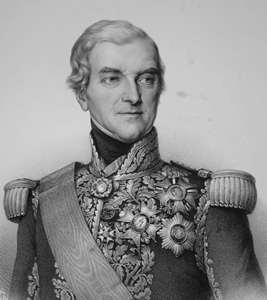General Guillaume Dode de la Brunerie

Born: April 30, 1775
Place of Birth: Saint-Geoire, Isère, France
Died: March 1, 1851
Place of Death: Paris, France
Arc de Triomphe: DODE on the south pillar
Pronunciation:
The son of a notary, Guillaume Dode entered the engineering school of Metz as a sous-lieutenant in March of 1794. That December he was assigned to the Army of Mainz and in March of 1795 he was promoted to lieutenant of engineers. Dode served with the Army of the Rhine from 1795 to 1797 and in August of 1795 he was promoted to capitaine. In 1796 he served at the crossing of the Rhine near Kehl and he served with Delmas' division. In January of 1797 Dode directed the work on the bridgehead of Huningue and he helped defend Huningue. Three months later in April he directed a false attack near Fort Vauban during the second crossing of the Rhine. Dode was next sent to Toulon and in February of 1798 he joined the Army of England before he was assigned to the Army of the Orient.
In May of 1798 Dode embarked at Marseille for Egypt on the frigate Alceste as part of Reynier's division. In June he took part in the descent on the isle of Gozzo and he commanded the attack directed against Fort Chambray. Next Dode was attached to the team working on bridges under Andreossy, and later he went on to direct the work at Gizeh, Old Cairo, and Alexandria. In May of 1800 he was promoted to chef de bataillon and afterwards he was attached to General Friant's division. After the French surrender in Egypt in 1801, Dode was transported back to France on the British ship Union.
In February of 1802 Dode was named deputy director of fortifications at Saint-Omer. The following year he fulfilled the same position at Boulogne. Next Dode directed the construction of the forts of Heurt and Crèche and all the works built along the coast between Cape Gris Nez and the mouth of the Canche. In January of 1804 he was named deputy chief of staff of the engineers of the Army of the Coasts of the Ocean under Marescot. In 1805 the Grande Armée marched out to confront the Third Coalition and Dode caught up to the army at Strasbourg. During the campaign of 1805 Dode served at the crossing of the Inn at Mühldorf, the bridges at Vienna, and at Hollabrunn. After the conclusion of the campaign he was promoted to colonel and named chief of staff of engineers of Marshal Lannes' V Corps.
Just before the start of the Prussian campaign in October of 1806, Dode took command of the engineers of V Corps. With V Corps he served at Saalfeld, Jena, Pultusk , and Ostrolenka . At the end of 1807 Dode was named a Knight of the Order of Military Merit of Bavaria and he was serving in Silesia with Marshal Mortier. In 1808 he was named Baron of La Brunerie, becoming Guillaume Dode de la Brunerie. Dode de la Brunerie was next sent to Spain where he took part in the second Siege of Saragossa in 1809 and afterwards he was promoted to général de brigade. That June he was named chief of staff of engineers of the Army of Spain and in 1810 he returned to France. Over the following months Dode de la Brunerie inspected the fortifications at Ostend, Nieuport, Dunkirk, Calais, Boulogne, Montreuil, and Abbeville.
In 1812 Dode de la Brunerie took command of the engineers of Marshal Ney's III Corps for the campaign against Russia. During that campaign, in August he transferred to II Corps and he went on to serve at Polotsk, Tschasnicki, and Tchieria. In November Dode de la Brunerie joined Victor's IX Corps and he served at Borisow and then the Battle of the Berezina. Only a few days later he was ordered to prepare the defenses of Glogau and Custrin. In 1813 Dode de la Brunerie did not actively campaign as part of a corps in Saxony, instead he commanded the engineers of the Corps of Observation of Mainz under Marshal Augereau. That November he was ordered to inspect all the forts from Landau to the Swiss border and then he was sent to Italy to take command of the engineers of the Army of Italy.
After Napoleon's abdication in April of 1814, Dode de la Brunerie returned to Paris where he was promoted to lieutenant general. When Napoleon was returned to power in 1815 for the Hundred Days, he confirmed Dode de la Brunerie's rank but did not actively employ him. Dode de la Brunerie continued to have a successful career after the Second Restoration and he was named a Marshal of France in 1847.
Bibliography
- Divry, Arnauld. Les Noms Gravés sur l'Arc de Triomphe. Paris: L'Harmattan, 2017.
- Six, Georges. Dictionnaire Biographique des Généraux & Amiraux Français de la Révolution et de l'Empire (1792-1814). 2 vols. Paris: Gaston Saffroy, 2003.
External Links:
Updated February 2022
© Nathan D. Jensen